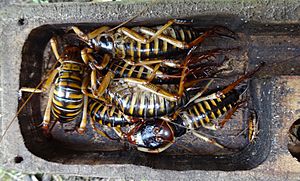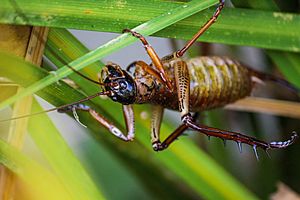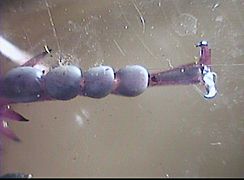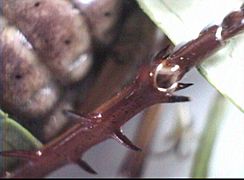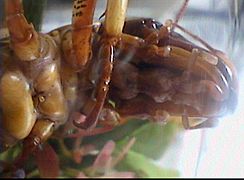Wētā facts for kids
Quick facts for kids Wētā |
|
|---|---|
 |
|
| Male Wellington tree wētā | |
| Scientific classification | |
| Kingdom: | |
| Phylum: | |
| Class: | |
| Order: | |
| Suborder: | |
| Superfamily: |
Stenopelmatoidea,
Rhaphidophoroidea |
| Family: |
Anostostomatidae,
Rhaphidophoridae |
Wētā (also spelled weta) are a group of about 70 different insect species. They live only in New Zealand. These insects are like giant, flightless crickets. Some wētā are among the heaviest insects in the world!
Most wētā are active at night. Smaller species usually eat meat, like other insects. Larger wētā mostly eat plants. Sadly, new animals brought to New Zealand, like rats and cats, hunt wētā. Because of this, some wētā species are now in danger of disappearing forever.
Contents
What's in a Name?
The word "wētā" comes from the Māori language. It's the name for this whole group of big insects. In New Zealand, people spell it "weta" or "wētā". Using the line above the 'a' (called a macron) is becoming more common. This is because the Māori word "weta" (without the macron) means "filth" or "excrement." So, "wētā" with the macron is the correct way to say it.
Amazing Wētā Features
Many wētā are very big for insects. Some are even among the largest and heaviest in the world! They look a bit like a katydid or a cricket. Their back legs are big and often very spiky. Most wētā cannot fly.
Wētā can live in many different places. You can find them in mountains, forests, grasslands, caves, and even city gardens. They are active at night. All wētā species in New Zealand cannot fly.
What Wētā Eat
Different wētā species eat different things. Most wētā are predators. This means they hunt and eat other small creatures. Some are omnivores, eating both plants and animals. But the giant wētā and tree wētā mostly eat plants. They munch on things like leaves, flowers, seeds, and fruit.
Wētā Life Cycle
Male giant wētā are smaller than females. They compete to find mates. Male tree wētā have bigger heads than females. They often live with several females and fight other males.
Ground wētā males sometimes give food gifts to females when they mate. Some female ground wētā even take care of their babies. Wētā lay their eggs in the soil during autumn and winter. The eggs hatch the next spring. It takes one to two years for a wētā to grow into an adult. As they grow, they shed their skin about ten times!
How Wētā Defend Themselves
Wētā can bite with their strong jaws. Tree wētā bites can hurt, but they don't happen very often. When a tree wētā feels threatened, it lifts its spiky back legs. This makes it look bigger and scarier. But usually, they just try to run away if they can.
Tree wētā also rub their back legs against their bodies to make a loud sound. This is called stridulation. They do this to warn enemies. This sound is also used when males fight over their homes. Female wētā have a long part that looks like a stinger. But it's actually an ovipositor. They use it to lay their eggs inside rotting wood or soil. Some ground wētā have short ovipositors. They use them to lay eggs in special underground chambers.
Wētā Families

Wētā are very old insects. Scientists think they were around when the supercontinent Gondwanaland existed. New Zealand used to be part of Gondwanaland. Most wētā species are found in the southern half of the world.
There are two main families of wētā in New Zealand:
- Anostostomatidae: This family includes giant wētā, tree wētā, ground wētā, and tusked wētā.
- Rhaphidophoridae: This family includes cave wētā, also known as tokoriro. They are not as closely related to the other wētā types.
Types of Wētā
There are many different kinds of wētā! Here are some of the most well-known types:
Giant Wētā

The 11 species of giant wētā (Deinacrida spp.) live only in New Zealand. In Māori, they are called wētā punga. These wētā are huge! Their bodies can be up to 100 millimeters (about 4 inches) long. They can weigh about 20–30 grams. One giant wētā, full of eggs, weighed a record 70 grams! This makes it one of the heaviest insects ever recorded. It was even heavier than a sparrow.
The biggest giant wētā is the Little Barrier Island wētā. Giant wētā are usually less social than tree wētā. They are also more peaceful. The name Deinacrida means "terrible grasshopper" in Greek. You can mostly find giant wētā on small islands off New Zealand's coast. Some also live high up in the mountains of the South Island.
Tree Wētā
Tree wētā (Hemideina) are common in towns and cities in New Zealand's North Island. They can grow up to 40 millimeters (about 1.5 inches) long. They usually live in holes in trees. These holes are often made by other insects or by rot. The wētā keeps the hole clean. It chews away any new bark that tries to close the opening.
You can even put a piece of wood with a pre-made hole, called a "wētā motel," in your garden. Tree wētā might move in and become your pets! A single hole can be home to one male and up to 10 adult females. Tree wētā are active at night. They eat plants and small insects. Male tree wētā have much bigger jaws than females. Both males and females will make a loud sound and bite if they feel threatened.
There are seven species of tree wētā (pūtangatanga in Māori):
- The Auckland tree wētā (Hemideina thoracica) lives across the North Island, except for the Wellington area.
- The Wellington tree wētā (Hemideina crassidens) lives in Wellington, the Wairarapa, and parts of the South Island.
- Hemideina trewicki is found in Hawke's Bay.
- H. femorata lives in Marlborough and Canterbury.
- The rare H. ricta species is found on Banks Peninsula.
- The West Coast bush wētā (H. broughi) lives in Nelson and the northern West Coast.
- H. maori, the mountain stone wētā, lives high up in the Southern Alps.
Tusked Wētā
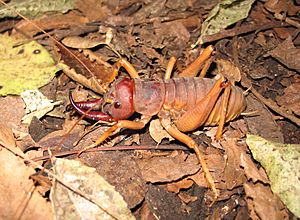
Tusked wētā are special because the males have long, curved tusks. These tusks stick out from their jaws. They use these tusks to fight other males, not for biting. Female tusked wētā look similar to ground wētā. Tusked wētā mainly eat meat, like worms and insects.
There are three known species:
- The Northland tusked wētā (Anisoura nicobarica) lives in tree holes.
- The Mercury Islands tusked wētā (Motuweta isolata) was found in 1970. It lives on the ground and buries itself in shallow holes during the day. This species is in great danger. Conservation programs are helping to create new groups of them on other islands.
- The Raukumara tusked wētā (Motuweta riparia) was found in 1996. It has a very unusual habit: if it feels threatened, it will dive into streams and hide underwater for up to three minutes!
Ground Wētā
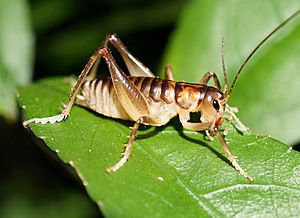
Ground wētā belong to the genus Hemiandrus. About 30 species of ground wētā live in New Zealand. They hide in burrows in the ground during the day. Some species that live in open areas make a special door to cover their burrow entrance. At night, ground wētā hunt other small creatures and eat fruit. Most female ground wētā have long ovipositors. But some have short ones and take care of their young.
Cave Wētā
The 60 species of cave wētā or tokoriro are only distant relatives of the other wētā types. They are in a different family. They have very long antennae. They may also have long, thin legs and a calm nature. They don't have ears on their front legs like other wētā. But some are very good at feeling vibrations in the ground through special pads on their feet. Special hairs and organs on their antennae also help them feel low-frequency vibrations in the air.
Even though they are called "cave wētā," most species live in forests. You can find them among fallen leaves, in logs, tree holes, and between rocks. Cave-dwelling species might be active inside their caves during the day. Those near cave entrances might go outside at night.
Protecting Wētā
Before humans arrived, wētā had natural enemies like birds (such as the weka and kiwi), reptiles, and bats. But new animals brought to New Zealand, like cats, hedgehogs, rats, and stoats, have caused a huge increase in wētā deaths. Wētā are also in danger because humans destroy their homes.
New Zealand's Department of Conservation says that 16 of the 70 wētā species are at risk. Since the 1970s, programs have been set up to stop these amazing insects from disappearing. Some very endangered species are even tracked with tiny radio devices to help protect them.
See also
 In Spanish: Weta para niños
In Spanish: Weta para niños



